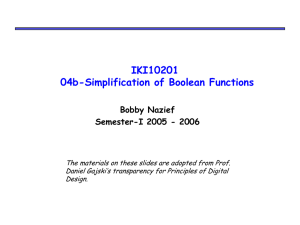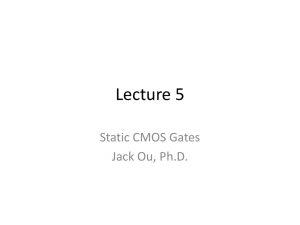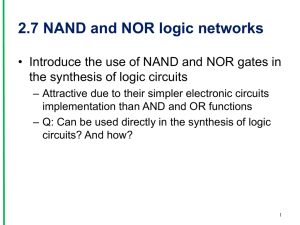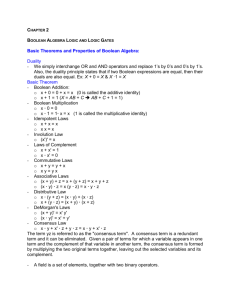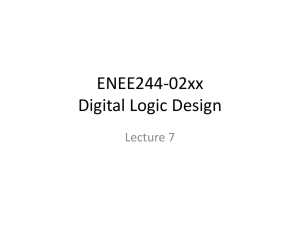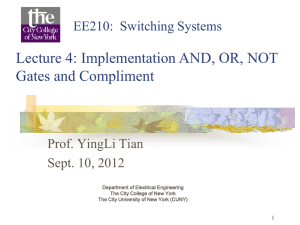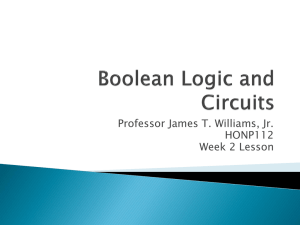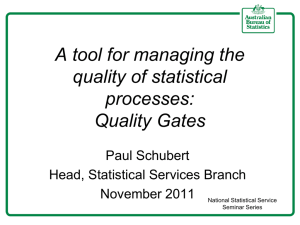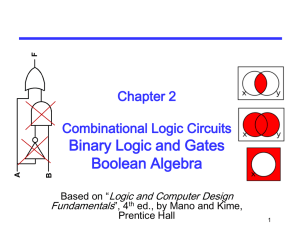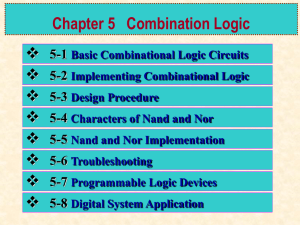Common Postulates Boolean Algebra
advertisement
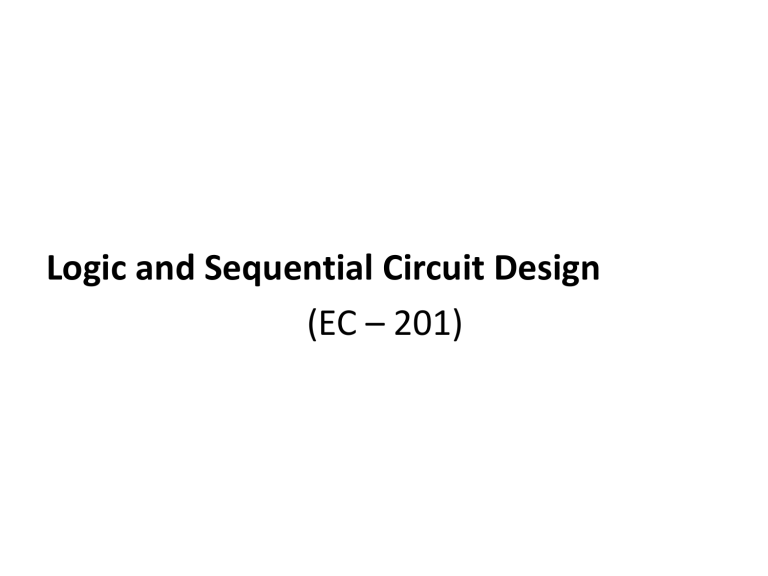
Logic and Sequential Circuit Design
(EC – 201)
Textbook
Digital Logic and Computer Design by M.
Morris Mano (Jan 2000 )
Topics
•
•
Boolean Algebra and Logic Gates: Binary Logic and
Gates, Boolean Algebra and Functions, Canonical
and Standard Forms, Logic Operations, Digital Logic
Gates, and IC Digital Families.
Simplification of Boolean Functions: K-Map
Method and Simplification using Different Variables
Map, Simplification of Product of Sums,
Implementation with NAND and NOR Gates, Don’t
Care Conditions, The Tabulation Method,
Determination of Prime-Implicants, and Selection
of Prime-Implicants.
Continue…
•
•
Combinational Logic Design: Design Procedure,
Adders, Subtractors, Code Conversion, Analysis
Procedure, Multilevel NAND Circuits, Multilevel
NOR Circuits, Exclusive-OR, and Equivalence
Functions
Combinational Logic with MSI and LSI: Decimal
Adder, Magnitude Comparator, Decoders,
Encoders, Multiplexers, Demultiplexers, Binary
Adders, Binary Subtraction, Binary AdderSubtractors, Binary Multipliers and HDL
Representation – VHDL/Verilog
Continue…
• Sequential Logic/Circuits: Latches, Flip-Flops,
Triggering of Flip-Flops, Clocked Sequential Circuits
and their Analysis, State Reduction and Assignment,
Flip-Flop Excitation Tables, Design Procedure,
Designing with D & JK Flip-Flops, HDL/Verilog
Representation for a Sequential Circuits –
VHDL/Verilog
Boolean Algebra
&
Logic Gates
Common Postulates (Boolean Algebra)
• Closure
N={1,2,3,4,5,…..}
It is closed w.r.t +
i.e. a+b=c
as
a,b,cΣN
• Associative Law
(x*y)*z = x*(y*z)
for all x,y,z,ΣS
• Commutative Law
x*y = y*x for all x,yΣS
x+y = y+x
x+y = y+x
x.Y = y.x
Common Postulates (Boolean Algebra)
• Identity Element
x+0 = 0+x = x
x.1 = 1.x = x
e*x = x*e = x
e+x = x+e = x
0+x = x+0 = x
1*x = x*1 = x
• Inverse
x+x’ = 1 x*y = e a*1/a = 1
x+y = e
x.x’ = 0 a+(-a) = 0
• Distributed Law
x*(y.z) = (x*y) . (x*z)
x.(y+z) = (x.y) + (x.z)
x+(y.z) = (x+y) . (x+z)
xΣS
Boolean Algebra and Logic Gates
x
y
x.y
x
y
x+y
x
x’
0
0
0
0
0
0
0
1
0
1
0
0
1
1
1
0
1
0
0
1
0
1
1
1
1
1
1
1
x.(y+z) = (x.y)+(x.z)
x
y
z
Y+z
x.(y+z)
x.y
x.z
(x.y)+x.z
0
0
0
0
0
0
0
0
0
0
1
1
0
0
0
0
0
1
0
1
0
0
0
0
0
1
1
1
0
0
0
0
1
0
0
0
0
0
0
0
1
0
1
1
1
0
1
1
1
1
0
1
1
1
0
1
1
1
1
1
1
1
1
1
Postulates and Theorems of Boolean Algebra
Postulate 2
(a) x+0 = x
(b) x.1 = x
Postulate 5
(a) x+x’ = 1
(b) x.x’ = 0
Theorem 1
(a) x+x = x
(b) x.x = x
Theorem 2
(a) x+1 = 1
(b) x.0 = 0
Theorem3, involution
(x’)’ = x
Postulate3, commutative
(a) x+y = y+x
(b) xy = yx
Theorem4, associative
(a) x+(y+z)=(x+y)+z
(b) x(yz) = (xy)z
Postulate4, distributive
(a) x(y+z)=xy+xz
(b) x+yz = (x+y)(x+z)
Theorem5, DeMorgan
(a) (x+y)’ = x’y’
(b) (xy)’ = x’+y’
Theorem6, absorption
(a) x+xy = x
(b) x(x+y)=x
Theorems
1a.
1b.
x+x = x
x+x = (x+x).1
= (x+x)(x+x’)
= x+xx’
=x+0
=x
x.x = x (Remember Duality of 1a)
x.x = xx+0
= xx+xx’
= x(x+x’)
= x.1
=x
Theorems
2a.
2b.
x+1 = 1
x+1 =1.(x+1)
= (x+x’)(x+1)
= (x+x’)
= x+x’
=1
X.0 = 0 (Remember Duality of
of 2a)
3.
6a
6b.
(x’)’ = x
Complement of x = x’
Complement of x’ = (x’)’ = x
x+xy = x
x+xy = x.1+xy
= x(1+y)
= x.1
=x
x(x+y) = x (Remember Duality of 6a)
Can also be proved using truth table method
x
y
xy
x+xy
0
0
0
0
0
1
0
0
1
0
0
1
1
1
1
1
x=x+xy
x
y
x+y
(x+y)’
x’
y’
x’y’
0
0
0
1
1
1
1
0
1
1
0
1
0
0
1
0
1
0
0
1
0
1
1
1
0
0
0
0
(x+y)’ = x’y’ DeMorgan’s Theorem
(xy)’ = x’ +y’ DeMorgan’s Theorem
Operator Precedence
1.( )
2.NOT
3.AND
4.OR
x
y
xy’
xy
x
y
x’y
x’y’
VENN DIAGRAM FOR TWO VARIABLES
x
y
VENN DIAGRAM ILLUSTRATION X=XY+X
x
z
z
x+(y+z)
y
xy+xz
VENN DIAGRAM ILLUSTRATION OF THE DISTRIBUTIVE LAW
TRUTH TABLE FOR F1=xyz’, F2=x+y’z, F3=x’y’z+x’yz+xy’ and F4=xy’+x’z
x
y
z
F1
F2
F3
F4
0
0
0
0
0
0
0
0
0
1
0
1
1
1
0
1
0
0
0
0
0
0
1
1
0
0
1
1
1
0
0
0
1
1
1
1
0
1
0
1
1
1
1
1
0
1
1
0
0
1
1
1
0
1
0
0
z
x
y
x
F1
F2
y
z
(a) F1 = xyz’
(b) F2 = x+y’z
x
y
F3
z
(c) F3 = x’y’z+x’yz+xy’
x
y
F4
(c) F4 = xy’+x’z
z
Implementation of Boolean Function with GATES
Algebraic Manipulations for Minimization of Boolean Functions
(Literal minimization)
1.
2.
3.
4.
5.
x+x’y = (x+x’)(x+y)
= 1.(x+y)=x+y
x(x’+y) = xx’+xy
= 0+xy=xy
x’y’z+x’yz+xy’
= x’z(y’+y)+xy’
= x’z+xy’
xy+x’z+yz
(Consensus Theorem)
=xy+x’z+yz(x+x’)
=xy+x’z+xyz+x’yz
=xy(1+z)+x’z(1+y)
=xy+x’z
(x+y)(x’+z)(y+z)=(x+y)(x’+z)
by duality from function 4
Complement of a Function
(A+B+C)’ = (A+X)’
= A’X’
= A’.(B+C)’
= A’.(B’C’)
= A’B’C’
(A+B+C+D+…..Z)’ = A’B’C’D’…..Z’
(ABCD….Z)’ = A’+B’+C’+D’+….+Z’
Example using De Morgan’s Theorem (Method-1)
F1 = x’yz’+x’y’z
F1’ = (x’yz’+x’y’z)’
= (x+y’+z)(x+y+z’)
F2 = x(y’z’+yz)
F2’= [x(y’z’+yz)]’
= x’+(y+z)(y’+z’)
Example using dual and complement of each
literal (Method-2)
F1 = x’yz’ + x’y’z
Dual of F1 = (x’+y+z’)(x’+y’+z)
Complement F1’ = (x+y’+z)(x+y+z’)
F2 = x(y’z’+yz)
Dual of F2=x+[(y’+z’)(y+z]
Complement =F2’= x’+ (y+z)(y’+z’)
Minterm or a Standard Product
n variables forming an AND term provide 2n possible
combinations, called minterms or standard products
(denoted as m1, m2 etc.).
Variable primed if a bit is 0
Variable unprimed if a bit is 1
Maxterm or a Standard Sum
n variables forming an OR term provide 2n possible
combinations, called maxterms or standard sums
(denoted as M1,M2 etc.).
Variable primed if a bit is 1
Variable unprimed if a bit is 0
MINTERMS AND MAXTERMS FOR THREE BINARY VARIABLES
MINTERMS
MAXTERMS
x
y
z
Term
Designation
Term
Designation
0
0
0
x’y’z’
m0
x+y+z
M0
0
0
1
x’y’z
m1
x+y+z’
M1
0
1
0
x’yz’
m2
x+y’+z
M2
0
1
1
x’yz
m3
x+y’+z’
M3
1
0
0
xy’z’
m4
x’+y+z
M4
1
0
1
xy’z
m5
x’+y+z’
M5
1
1
0
xyz’
m6
x’+y’+z
M6
1
1
1
xyz
m7
x’+y’+z’
M7
FUNCTION OF THREE VARIABLES
x
y
z
Function f1
Function f2
0
0
0
0
0
0
0
1
1
0
0
1
0
0
0
0
1
1
0
1
1
0
0
1
0
1
0
1
0
1
1
1
0
0
1
1
1
1
1
1
f1 = x’y’z+xy’z’+xyz
=m1 + m4 + m7
f2 = x’yz+xy’z+xyz’+xyz = m3 + m5 + m6 + m7
MINTERMS AND MAXTERMS FOR THREE BINARY VARIABLES
f1 = x’y’z+xy’z’+xyz
f1’ = x’y’z’+x’yz’+x’yz+xy’z+xyz’
f1 =(x+y+z)(x+y’+z)(x+y’+z’)(x’+y+z’) (x’+y’+z)
= M0.M2.M3.M5.M6
= M0M2M3M5M6
f2 = x’yz+xy’z+xyz’+xyz
f2’ = x’y’z’+x’y’z+x’yz’+xy’z’
f2 = (x+y+z)(x+y+z’)(x+y’+z)(x’+y+z)
= M0 M1 M2 M4
Canonical Form
Boolean functions expressed as a sum of minterms or product of
maxterms are said to be in canonical form.
M3+m5+m6+m7 or M0 M1 M2 M4
Sum of Minterms (Sum of Products)
Example:
F = A+B’C
F = A(B+B’)+B’C(A+A’)
= AB+AB’+AB’C+A’B’C
= AB(C+C’)+AB’(C+C’)+AB’C+A’B’C
= ABC+ABC’+AB’C+AB’C’+AB’C+A’B’C
= A’B’C+AB’C’+AB’C+ABC’+ABC
= m1+m4+m5+m6+m7
F(A,B,C)=(1,4,5,6,7)
ORing of term AND terms of variables A,B &C
They are minterms of the function
Product of Maxterms (Product of sums)
Example:
F = xy+x’z
F = xy+x’z
F = (xy+x’)(xy+z)
distr.law (x+yz)=(x+y)(x+z)
= (x+x’)(y+x’)(x+z)(y+z)
= (x’+y)(x+z)(y+z)
= (x’+y+zz’)(x+z+yy’)(y+z+xx’)
= (x’+y+z)(x’+y+z’)(x+z+y)(x+z+y’)(y+z+x)(y+z+x’)
= (x+y+z)(x+y’+z)(x’+y+z)(x’+y+z’)
= M0 M2 M4 M5
F(x,y,z) = (0,2,4,5)
ANDing of terms
Maxterms of the function (4 OR terms
of variables x,y&z)
Conversion between Canonical Forms
F(A,B,C) = (1,4,5,6,7)
sum of minterms
F’(A,B,C) = (0,2,3)
= m0+m2+m3
F(A,B,C) = (m0+m2+m3)’
= m0’.m2’.m3’
= M0 M2 M3
= (0,2,3)
Product of maxterms
Similarly
F(x,y,z) = (0,2,4,5)
F(x,y,z) = (1,3,6,7)
Standard Forms
Sum of Products (OR operations)
F1 = y’+xy+x’yz’
(AND term/product term)
Product of Sums (AND operations)
F2=x(y’+z)(x’+y+z’+w)
(OR term/sum term)
Non-standard form
F3=(AB+CD)(A’B’+C’D’)
Standard form of F3
F3=ABC’D’ + A’B’CD
TRUTH TABLE FOR THE 16 FUNCTIONS OF TWO
BINARY VARIABLES
x
y
F0
F1
F2
F3
F4
F5
F6
F7
F8
F9
F10
F11
F12
F13
F14
F15
0
0
0
0
0
0
0
0
0
0
1
1
1
1
1
1
1
1
0
1
0
0
0
0
1
1
1
1
0
0
0
0
1
1
1
1
1
0
0
0
1
1
0
0
1
1
0
0
1
1
0
0
1
1
1
1
0
1
0
1
0
1
0
1
0
1
0
1
0
1
0
1
,
,
Operator
symbols
+
F0 = 0
F1 = xy
F2 = xy’
F3 = x
F4 = x’y
F5 = y
F6 = xy’ +x’y
F7= x +y
F8 = (x+y)’
F9 = xy +x’y’
F10 = y’
F11 = x +y’
F12 = x’
F13 = x’ + y
F14 = (xy)’
F15 = 1
BOOLEAN EXPRESSIONS FOR THE 16 FUNCTIONS OF TWO VARIABLE
BOOLEAN OPERATOR
FUNCTIONS
SYMBOL
F0 =0
NAME
COMMENTS
NULL
F1=xy
x.y
F2=xy’
F3=x
F4=x’y
F5=y
F6=xy’+x’y x
F7=x+y
F8=(x+y)’
F9=xy+x’y’
F10=y’
F11=x+y’
F12=x’
F13=x’+y
F14=(xy)’
F15=1
x/y
y/x
y
x
x
x’
x+y
y
y
y’
xy
xy
x
y
AND
BINARY CONSTANT 0
x and y
inhibition
x but not y
transfer
x
inhibition
y but not x
transfer
y
exclusive-OR
x or y but not both
OR
x or y
NOR
not OR
*equivalence
x equals y
complement
not y
implication
if y then x
complement
not x
implication
if x then y
NAND
not AND
IDENTITY
BINARY CONSTANT 1
• *Equivalence is also known as equality, coincidence, and exclusive
NOR
• 16 logic operations are obtained from two variables x &y
• Standard gates used in digital design are: complement, transfer, AND,
OR , NAND, NOR, XOR & XNOR (equivalence).
H and L LEVEL IN IC LOGIC FAMILIES
IC Family Voltage
High-level voltage Low-level
Type
Supply (V)
(V) voltage (V)
Range
Typical
TTL
Vcc=5
2.4-5
3.5
ECL
VEE=-5.2 -0.95- -0.7 -0.8
CMOS VDD=3--10 VDD
VDD
Positive Logic:
Logic-1
Negative Logic
Logic-0
Range
Typical
0-0.4
0.2
-1.9-- -1.6 -1.8
0-0.5
0
Logic-0
Logic-1
TYPICAL CHARACTERISTICS OF IC
LOGIC FAMILIES
IC Logic
Family
Standard TTL
Shottky TTL
Low power
Shottky TTL
ECL
CMOS
Fan out
Power
Dissipation (mw)
Propagation
delay (ns)
Noise Margin (v)
10
10
10
22
10
3
0.4
0.4
20
25
50
2
25
0.1
10
2
25
0.4
0.2
3
TTL basic circuit : NAND gate
ECL basic circuit: NOR gate
CMOS basic circuit: Inverter to construct NAND/NOR
DIGITAL LOGIC GATES
NAME
GRAPHIC
SYMBOL
AND
X
Y
TRUTH
TABLE
F=XY
X
0
0
1
1
Y
0
1
0
1
F
0
0
0
1
F=X+Y
X
0
0
1
1
Y
0
1
0
1
F
0
1
1
1
F
OR
X
Y
ALGEBRIC
FUNCTION
F
NAME
GRAPHIC
SYMBOL
ALGEBRIC
FUNCTION
Inverter
X
F
F=X’
X
0
1
F
1
0
F=X
X
0
1
F
0
1
Buffer
X
NAND
X
Y
F
F
TRUTH
TABLE
F=(XY)’
X
0
0
1
1
Y
0
1
0
1
F
1
1
1
0
NAME
NOR
Exclusive-OR
(XOR)
Exclusive-NOR
or
Equivalence
GRAPHIC
SYMBOL
X
Y
F
X
Y
TRUTH
TABLE
F=(X+Y)’
X
0
0
1
1
Y
0
1
0
1
F
1
0
0
0
X
0
0
1
1
Y
0
1
0
1
F
0
1
1
0
X
0
0
1
1
Y
0
1
0
1
F
1
0
0
1
F=XY’+X’Y
=XY
F
X
Y
ALGEBRIC
FUNCTION
F
F=XY+X’Y’
=X Y
(X+Y)’
x
[Z+(X+Y)’]’
Y
(X
Y) Z=(X+Y) Z’
=XZ’+YZ’
Z
(X ( Y Z)=X’(Y+ Z)
X
=X’Y+X’Z
[X+(Y+Z)’]’
(Y+Z)’
Y
Z
Demonstrating the nonassociativity of the NOR operator
(X Y) Z X (Y Z)
X
Y
Z
(X+Y+Z)’
(a) There input NOR gate
X
Y
Z
(XYZ)’
(b) There input NAND gate
A
B
C
F=[(ABC)’. (DE)’]’=ABC+DE
D
E
(c) Cascaded NAND gates
Multiple-input AND cascaded NOR and NAND gates
TRUTH TABLE
X
Y
F=X Y Z
Z
(a) Using two input gates
X
Y
Z
X
0
0
0
0
1
1
1
1
Y
0
0
1
1
0
0
1
1
Z
0
1
0
1
0
1
0
1
F
0
1
1
0
1
0
0
1
1
0
0
1
0
1
1
0
XOR
F=X Y Z
XNOR
(b) Three input gates
(b) Three input exclusive OR gates
Odd
function
Even
function
IC DIGITAL LOGIC FAMILIES
TTL
Transistor- Transistor Logic
• Very popular logic family.
• It has a extensive list of digital functions.
• It has a large number of MSI and SSI devices, also has LSI devices.
ECL Emitter Coupled Logic
• Used in systems requiring high speed operations.
• It has a large number of MSI and SSI devices, also LSI devices.
MOS Metal-Oxide Semiconductor
• Used in circuit requiring high component density
• It has a large number of MSI and SSI devices, also LSI devices (mostly)
CMOS Complementary MOS
• Used in systems requiring low power consumption.
• It has a large number of MSI and SSI devices, also has LSI devices.
I2L Integrated - Injection Logic
• Used in circuit requiring high component density.
• Mostly used for LSI functions
Some Typical IC Gates
VCC
14
1
VCC
13
12
11 10
9
8
2
3
4
6
7
5
14 13
1
12
2
11 10
3
4
9
5
GND
7404 Hex Inverters
TTL gates
8
6
7
GND
7400 Quadruple 2-input
NAND gates
VCC 2
16 15
Some Typical IC Gates
14
13
12
11
10
9
10107 Triple
Exclusive – OR/
NOR gates
1 2
VCC 1
3
VCC 2
16
4
15
5
14
6
13
12
7
8
11
VEE 2 (-5.2V)
10
9
10102 Quadruple
2-Input NOR gate
VCC 1
1
2
3
4
5
6
7
8
VEE (-5.2V)
(3-15 V)
VDD
14
13
12
NC
11
10
9
8
C MOS
GATES
1
2
3
4
5
4002 dual 4 input NOR gates
6
7
NC
Vss (GND)
NC
NC
16 15
14
13
12
11
10
9
CMOS
GATES
1
2
3
4
5
6
VDD
7
8 Vss
(GND)
(3-15 V)
4050 Hex buffer
LOGIC
SIGNAL
LOGIC
SIGNAL
VALUE
VALUE
VALUE
VALUE
1
0
H
0
L
1
H
L
Negative Logic
Positive Logic
Signal amplitude assignment and type of logic
X
y
z
L
L
H
L
H
H
H
L
H
H
H
L
Truth table in terms of
x
TTL
7400
GATE
y
z
Gate block diagram
H and L
X
y
z
0
0
1
0
1
1
1
0
1
1
1
0
Truth table for positive logic
H=1,
L=0
x
y
z
Graphic symbol for
positive logic NAND gate
X
y
z
1
1
0
1
0
1
0
1
1
0
0
1
x
z
y
Graphic symbol for negative logic
NOR gate
Truth table for negative logic
L=1
H=0
Same gate can function
+ive logic NAND or -ive logic NOR
+ive logic NOR or -ive logic NAND
DEMONSTRATION OF POSITIVE AND
NEGATIVE LOGIC
Characteristics of IC logic families
(parameters)
Fan-out
Specifies the number of standard loads (the amount of current needed by an input
of another gate in the same IC family) that the output of a gate can drive without
impairing its normal operation. it is expressed by a number.
Power dissipation
It is the supplied power required to operate the gate. It is expressed in mw.
Propagation delay
It is the average transition delay time for a signal to propagate from input to
output when the binary signals change in value. It is expressed in ns.
Noise margin
It is the maximum noise voltage added to the input signal of a digital circuit that
does not cause an undesirable change in the circuit output. It is expressed in volts
(v).

